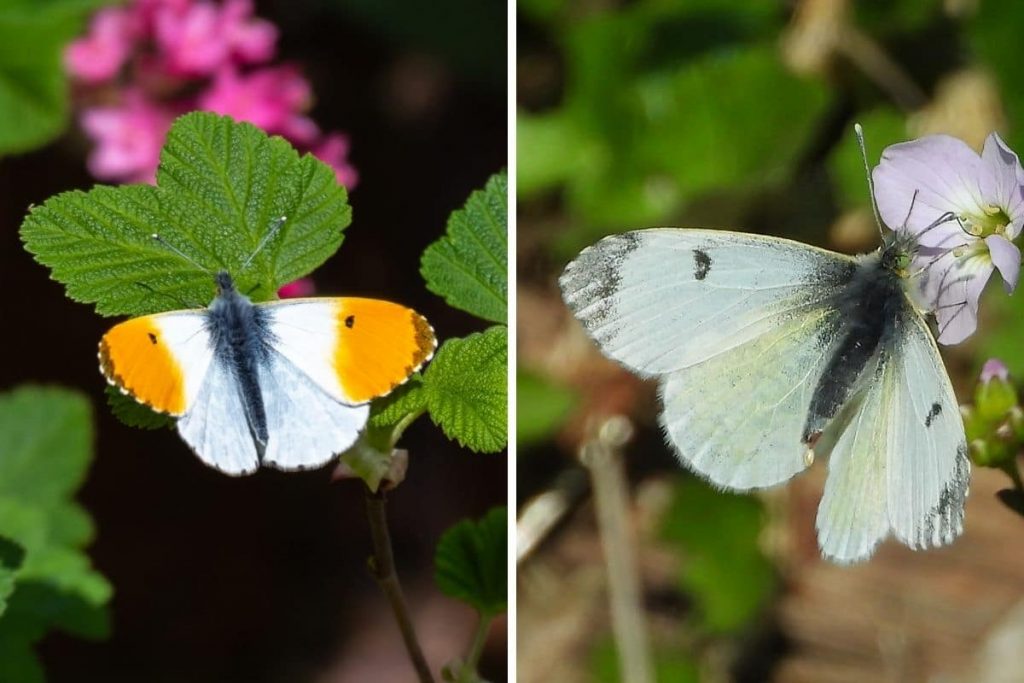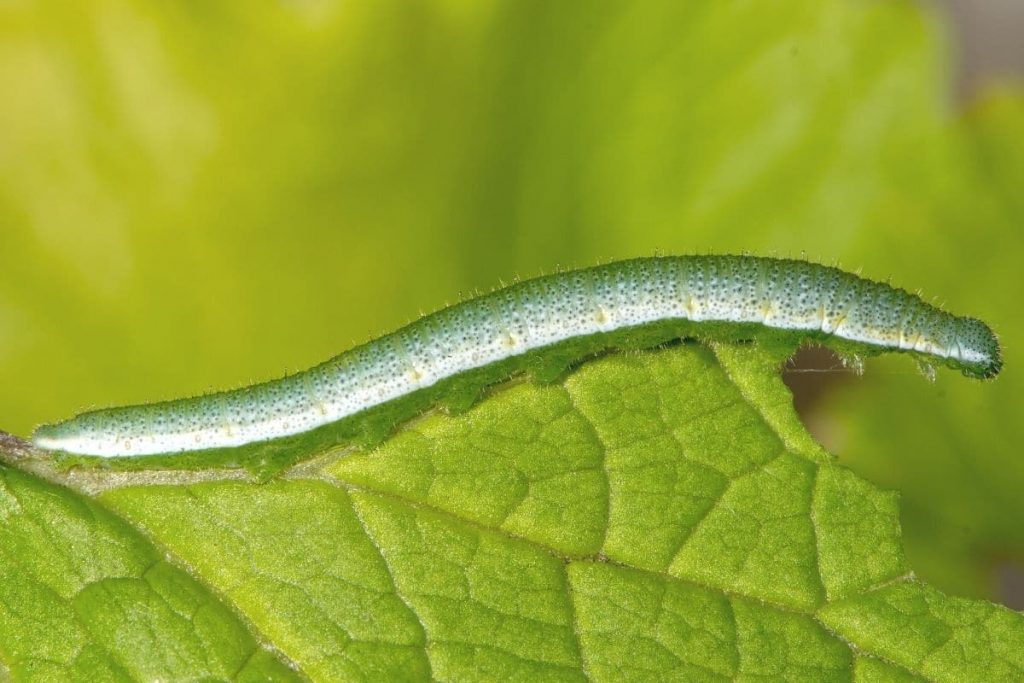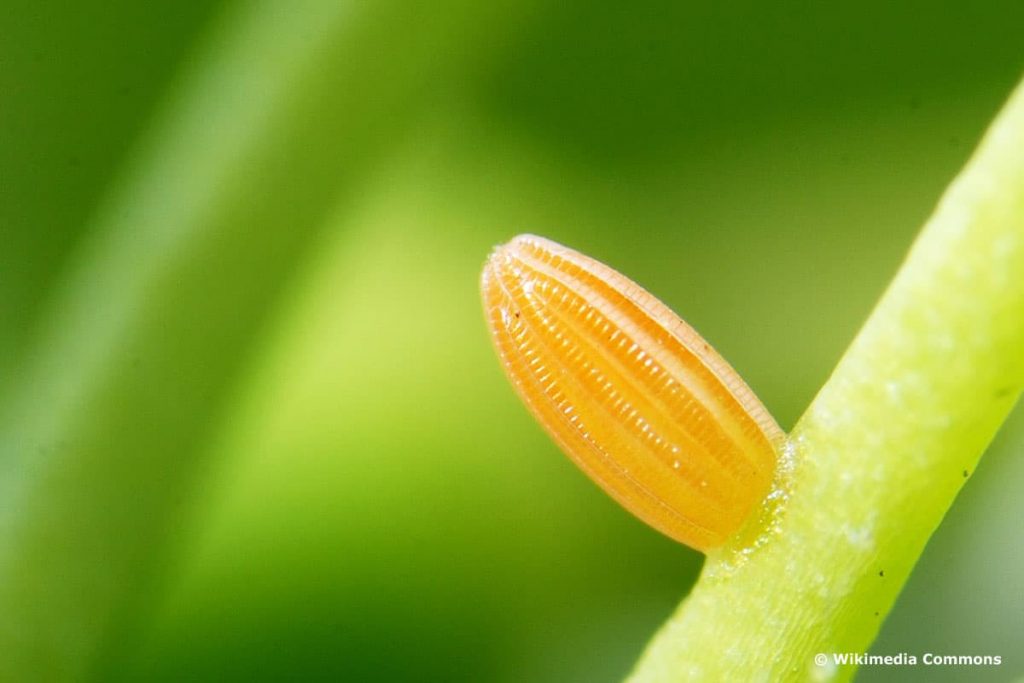A white-orange coloration makes the Aurora butterfly (Anthocharis cardamines) one of the most striking native butterflies. The goddess of dawn gave it its European name. How to recognize the butterfly.
Characteristics of the Aurora butterfly
The Aurora butterfly is a relatively colorful representative among the white butterflies and relatively petite. Although males and females are clearly different, they also have some similarities.
- white ground coloration on upper sides of both pairs of wings
- outermost tip of forewings gray to gray-black
- small black spot in the middle of forewings
- yellowish-green to grayish-green, irregular pattern on hindwing undersides
- wingspan 35 to 45 mm
- body size about 45 mm
- diurnal moth, life expectancy about 14 days

| Male | Female |
|---|---|
| Coloration more intense and conspicuous than that of females underside of forewings white and orange complete tip orange outer half of the forewings on the upper side strong orange | somewhat plainer in coloration prominent orange spot is missing almost pure white forewings white coloration predominant tip of forewings black easy to confuse with other whitewings |
Recognize caterpillars
on the upper side blue-green colored, fine hairy
covered with small blackish warts
on the sides of the body changing to white
white coloration strongly limited towards the bottom
undersides of the caterpillars dark green
difficult to recognize due to their coloration

- usually sit back downwards on the food plant
- reach body length of about 30 mm
- head end narrowed in a crescent shape
- go through different caterpillar stages
- overwinter as pupa
Tip: Immediately after laying, the eggs of the Aurora butterfly are whitish and turn bright orange within a short time.
Food plants
The most important nectar sources for the butterfly, which is conspicuous for its white and orange coloration, are
Meadow foamwort (Cardamine pratensis)
Garlic ragwort (Alliaria petiolata)
Other cruciferous plants that serve as a food source for moths and caterpillars:
- Annual silverleaf (Lunaria annua).
- Common night violet (Hesperis matronalis)
- Arrow cress (Lepidium draba)
- Rough-haired goosegrass (Arabis hirsuta)
- Towerwort (Arabis glabra)
- Water swamp cress (Rorippa amphibia)
- Winter cress (Barbarea vulgaris)
Occurrence
The distribution area extends over large parts of Europe. One can find these moths
in sparse, moist deciduous, coniferous, mixed and riparian forests,
on dry meagre meadows and roadsides
wet meadows
clearings,
shrubberies
near forests and
in gardens
in gardens.
The meadowfoam is particularly frequently approached. This butterfly, starting from the egg up to the adult butterfly, can find a full-fledged habitat in every semi-natural garden.
Way of life
The females lay their eggs on the sepals or flower stalks of the food plants, preferably on those of the meadowfoam. After a few days the caterpillars hatch. They feed on flowers and fruiting stems until they pupate after about five weeks and four molts. To do this, they look for the stem of a food plant, on which they pupate into a gray-brown or green girdle pupa, in which they also overwinter. While the caterpillars feed on flowers and fruiting stems, the adult moths suck the nectar of flowering cruciferous plants.

Flight time
The flight time or the appearance of this white and orange butterfly depends essentially on the temperatures.
usually from the beginning of April until June
in particularly warm regions already from the end of March
a little bit later (from mid/end of April until July) in cooler and higher altitudes
The eggs of the moth are found on the host plants during the complete moth flight season. The caterpillars can be observed from June to July.
Frequently asked questions
Does the Aurora butterfly belong to the protected species?
There is no concrete endangerment for this butterfly, even though it is observed more and more rarely lately. Its habitats and food plants should be preserved and protected in any case.
How old can these animals become?
These butterflies can reach an average age of 14 days. In contrast, the pupa can overwinter for two years. The insects undergo a pronounced developmental dormancy, during which the metabolism is partially shut down.
Can it be confused with other moths?
The male moths are unmistakable because of their intense coloration. The females are different. Due to the lack of orange coloration, they can easily be confused with the large and small cabbage white butterfly, the lemon butterfly female or the green vein white butterfly.

